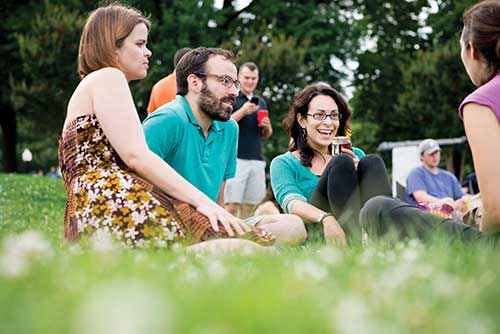Students thriving in “bad” East Baltimore say you shouldn’t believe everything you see on TV.
By Andrea Appleton
Blue lights blink menacingly above streets lined with boarded-up buildings, sirens as common as birdsong. In The Wire, a TV drama about the Baltimore drug wars that has shaped popular notions about the city, this is East Baltimore (as well as West). Bits of that image still ring true five years after the show went off the air, but there’s little doubt that the neighborhood is changing. “I’d never been to Baltimore until I came for Accepted Students Day,” says Caitlin Dreisbach, part of the 17-month fall-entry accelerated program. “A lot of my friends from college who heard I was going to Hopkins said, ‘Oh, great school! Bad city.'”

Classmate Carlee Peck works in the Office of Admissions and Student Services. “That’s the big question you get in Admissions: How safe do you feel?” she says. “I think Baltimore gets a bad rap, and this neighborhood in particular.”
Peck and Dreisbach are among a growing number of students who choose to live in today’s East Baltimore anyway–for its location, its diversity, and a few other positives “The Wire” never covered . While neighborhoods like Canton, Fells Point, Mount Vernon, and Charles Village still draw the lion’s share of students, Robin Lenzo, Hopkins’ director of housing, says East Baltimore is increasingly popular with them. Much of the draw is due to the 929 Apartments on North Wolfe Street, which opened just last year and has housed more than 200 students from the School of Medicine and more than 100 each from Nursing and Public Health.
You can’t beat the short walk to class or clinicals, though 929ers do admit that their schedules–home to class, class to home (with built-in fitness center and rooftop terrace)–can make it feel more like living in a bubble than a neighborhood. Not so for Lee Gilman, also in the accelerated program, who shared a Butcher’s Hill rowhouse this spring with two Public Health students. “I do feel like I’m more a part of the community,” he says. “I say ‘Hi!’ to my neighbors when they’re on the stoop. I make it a point to explore different neighborhoods.” (Gilman is going to give another funky Baltimore neighborhood, Hampden, a try this summer.)
Butcher’s Hill is also home to Wednesday trivia nights at The Life of Reilly, and students are all in–hitting the tavern fresh from work or class, sometimes in scrubs. (Quick: Who played “Omar” on The Wire?) Another favored spot is of course Fells Point, reachable by foot or the Charm City Circulator, a free bus. (“We really like getting tater tots at Ale Mary’s,” says Dreisbach.) Others steal a little off-campus study time at the Daily Grind coffee house on Thames Street or gather in one of the pubs set cheek-by-jowl along the waterfront. Patterson Park, in years past a magnet for crime, now beckons with tree-lined jogging paths and tranquil spots to sit and watch the birds that flock there as well.
Nearby farmers’ markets are popular, particularly since many urban neighborhoods lack a full-service grocery store. There are signs, however, that increased student traffic in East Baltimore is bringing more amenities. Cuban Revolution–a chain restaurant with provocatively titled dishes like the Bay of Pigs empanada platter–is open next to 929. Posters on North Wolfe Street herald the imminent arrival of Teavolve, an upscale cafe, and Milk & Honey Market. For a mini produce run, there’s the historic Northeast Market on Monument Street.
Although Dreisbach, Gilman, and Peck feel safety is not a problem, as in all urban environments residents need to exercise caution. “You have to prioritize, and at the end of the day, I prioritized convenience and location,” Dreisbach says.